Did Urban Revivo Rise Just Because Zara and H&M Fell Behind?
2025-06-16 11:00:00 | Sweekli
It entered the Chinese market the same year as Zara, yet remained lukewarm for over a decade. It wasn’t until its 11th year - when annual revenue reached nearly 3 billion CNY - that it finally turned a profit. Despite having stylish, high-end-looking stores, its price tags are only a fraction of luxury labels.
When global fast fashion giants like Zara and H&M began losing their luster and critics declared the fall of fast fashion in China, UR was heading in the opposite direction. After 2017, it took just five years for UR to double its annual revenue to 6 billion RMB, silencing the skeptics and defying the odds.
How did a brand once overshadowed by international powerhouses suddenly become the go-to wardrobe solution for Chinese women?
How does the local favorite cover every style scenario?
From a consumer’s perspective, UR seems to check every box for modern Chinese women - those in emerging first-tier cities. Whether it’s office wear, date-night outfits, or year-end party dresses, UR delivers. Its collections blend trendiness with versatility, offering something for every occasion.
This rising star has successfully lured urban women away from global fast fashion chains and into its own orbit. UR didn’t just survive - it reclaimed the fast fashion narrative in China. So how exactly did it pull this off?
Breaking Away from Western Aesthetics: Dismantling the Euro-American Look
Fast fashion initially boomed in China because brands like Zara, H&M, and C&A introduced Chinese consumers to a more globalized aesthetic. They widened the cultural lens on what was considered “fashionable.” Suddenly, bold colors, spaghetti straps, halter tops, and midriff-baring designs - all previously seen as “too much” - began to feel exciting and empowering.
These brands didn’t just sell clothes; they redefined the way an entire generation dressed. But in recent years, that dynamic has begun to shift.

Take a 38-year-old working woman from Guangdong. She told us that before falling in love with Urban Revivo, she had long been a loyal customer of Zara, H&M, C&A, and Uniqlo. What pushed her away from Zara, she says, was its retreat from physical stores in China—which also meant the end of regular in-store discounts. Meanwhile, UR’s designs felt fresher, bolder, and more youthful—plus, the prices made sense for her budget.
Another voice came from a student fashion blogger named “Nai Dong.” She used Zara as an example: while she found Zara’s styles visually appealing, she often felt the cuts were made for taller women. The straps were too long, pants too high-waisted, and even many dresses featured deep V-necks that made her feel exposed and uncomfortable with just the slightest movement.
One point kept coming up again and again in our conversations with Chinese shoppers: the sizing and fit of many global brands simply don’t work for East Asian body types.
UR’s popularity isn’t a fluke. Compared to international fast fashion giants, UR simply understands Chinese urban women better. From design choices to fit, from pricing to marketing tone, it speaks her language. You could say UR is taking back the fast fashion narrative in China - one well-fitted blouse at a time.
UR’s brick-and-mortar stores are destinations for weekly pilgrimages. Many women drop in just to check out the newest arrivals. According to data from Chanmama, UR’s core audience is made up of urban women in emerging first-tier cities, mostly in three age brackets: 18–23, 24–30, and 31–40. These women share a common trait: they are plugged in. They follow the latest “it” items on lifestyle platform rednote (the Chinese version of Instagram meets Pinterest) and regularly refresh their wardrobes. For them, fashion isn’t just about appearance - it’s a quick hit of dopamine.

The so-called “UR Girl” spans a wide age range, but her expectations from fashion are surprisingly aligned:
Affordable prices, trend-savvy design, and constant newness.
Fast fashion, at its best, feeds on the thrill of the new. And UR knows exactly how to deliver that thrill to Chinese women who are stylish, smart, and shopping on their own terms.
From a consumer’s point of view, stepping into a single UR store feels like unlocking a hundred different styles. Whether she wants something polished, playful, romantic, or bold - UR delivers. And if one brand can meet all her needs in terms of price, fit, variety, and trendiness, why go anywhere else?
From a business perspective, meeting as many of these style needs as possible means locking in loyalty -and revenue. The more wardrobe scenarios UR can cover, the deeper its connection with the customer and the bigger the slice of her spending it earns.
But serving women who expect value, great fit, sharp design, and fast turnaround isn’t easy. It’s a tall order that UR has been working on for nearly two decades.
From a once-obscure newcomer to today’s undisputed leader of China’s fast fashion scene, UR’s rise has been anything but accidental. Behind the brand’s ascent is a laser-sharp understanding of one thing: What Chinese women really want from fashion.
Defining Chinese Fast Fashion in 20 Years: The Rise of UR
Some sayUR only rose because Zara and H&M fell. But the truth is, UR didn’t just catch a lucky break - it spent nearly two decades preparing to seize this once-in-a-generation opportunity.

Back in 2006, most Chinese consumers had never heard the term “fast fashion.” Local womenswear brands rarely dared to open large-scale stores. Yet UR launched with a flagship store that spanned 1,000 square meters - a bold move in an era when 200 square meters was already considered ambitious.
Instead of blasting viral dance tracks like many malls at the time, UR played niche music that matched its elevated aesthetic. So it’s no surprise that when UR started gaining visibility, many shoppers assumed it was a foreign brand.
Behind the sleek stores was a founder, Li Mingguang, quietly laying the groundwork: investing in an in-house team of buyers and designers, building flexible supply chains, and implementing digital infrastructure. These weren’t short-term tactics - they were long-term bets that would eventually make UR a leading force in China’s fast fashion industry.
Early on, UR built a team of over 100 buyers and designers. Today, that team has grown to more than 500 people. Li himself spent years personally overseeing product design and still serves as the brand’s creative director, guiding its overall design direction. Compared to both local brands and international giants, UR has invested heavily in creative talent.
This wasn’t just about style - it was strategic. By building scalable systems early on in store operations, supply chain agility, and digital tools, UR could reduce marginal costs in the long run. That meant once it hit scale, the brand could cut costs while boosting efficiency.
Discounts are part of fast fashion’s DNA. When customers expect markdowns on nearly every item, brands must optimize every part of the supply chain to stay profitable. From design to manufacturing, logistics to post-sale service, UR found ways to trim fat and improve speed at each link.
With external financing, it scaled up operations and officially opened to franchise partnerships and online sales.
All that groundwork paid off. When UR opened franchise opportunities in 2014, growth accelerated dramatically. Within just three years, it hit 3 billion CNY in revenue and turned a profit for the first time.
With its foundation solid - spanning store systems, creative teams, and digital operations - UR was ready when global fast fashion brands stumbled.
In 2021, Zara, H&M, and others faced a major backlash in China for their public stance on Xinjiang cotton. The controversy led to a sharp contraction in their physical store presence and market share. UR, with all its systems already in place, was in the perfect position to fill the vacuum.
And UR’s edge wasn’t just infrastructure - it was cultural fluency.
As a brand born in China, UR grew up alongside Chinese consumer preferences and aesthetics. That’s something global brands can’t replicate overnight. Founder Li Mingguang even remarked in an interview that while Zara has built a design team in China, “I haven’t seen any real impact.” His point? Understanding local culture and fashion is a steep hill to climb.
Cracking the Code of Chinese Women—UR’s Secret? Buyers + AI
Fashion is personal. But fast fashion is deeply market-driven. It thrives on data, trends, and sharp instincts. In fact, no industry may be more obsessed with what people really want - right now - than fast fashion.
In recent years, UR has shifted from simply following trends to proactively defining consumer demand. Why? Because they’ve discovered a key insight about the women they serve: UR girls want it all. They want pieces that are personalized, yet practical. Outfits that express individuality while still solving real-life style problems.
That’s why UR’s design approach starts not with sketches, but with scenario-based thinking: What is this woman wearing to the office? On a date? To a friend’s party? The brand’s womenswear line is split into three series - LADY, WOMEN, and YOUTH. Within the WOMEN line, styles are further segmented into Casual, Trendy, Urban, and Athleisure, each targeting different fashion mindsets.
UR helped spark its rise by working with lifestyle platform rednote to analyze how UR girls dress - even though UR girls live in dense, hyper-urban environments, they’re looking to break free, at least stylistically. For office workers stuck in gray cubicles and subway crowds, a little bohemian flair (think breezy blouses, fringe accents, relaxed patterns) brings a sense of personal freedom. One statement piece is enough to turn Monday into something softer and more expressive.
Identifying demand is only the beginning. The real magic is how UR responds - with a system built around Buyer-Led Design + AI Prediction.
Founder Li Mingguang introduced a unique model called the Buyer-Centric System. Unlike traditional fashion brands where designers call the shots, at UR, buyers lead product direction, and designers help realize the vision. Because designers often create through a personal lens - what they find beautiful or innovative. But if that doesn’t align with consumer preferences, the results can be unsold inventory and tanked sales. In fast fashion, that’s a risk brands can’t afford.
Buyers, on the other hand, act as trend sensors. They understand what consumers are willing to pay for, what’s trending online, and what combinations of style + price = a hit. They’re the ones who translate vague style desires into sellable garments.
UR has built an in-house digital system that creates hyper-detailed profiles of both its customers and the wider market. Using AI, the system analyzes social media trends, influencer outfit data, color palettes, fabrics, cuts, and pattern preferences. It detects subtle shifts in consumer taste - often before they show up in sales reports.
UR doesn’t do this alone. It partners with rednote, Taobao, and Tmall, using their massive data sets to co-develop product insights. That Boho trend we just mentioned? It was a direct result of these cross-platform collaborations, backed by algorithmic pattern recognition and social listening.
This isn’t just about predicting what’s in - it’s about boosting the hit rate of new designs, so more products fly off the racks and fewer end up in clearance bins.

Fashion is a fiercely competitive game. But fast fashion? That’s a whole other beast. The pace is brutal, the stakes are high, and consumer taste changes faster than the seasons. For UR, the only way forward is to keep moving.
The entire company operates like a well-oiled engine - powered by style and technology, driven by agility. And that momentum? It’s what keeps others chasing in its wake.
Next year, UR will celebrate its 20th anniversary.
Its founder, Li Mingguang, once said: “Most Chinese fashion brands only get 20 good years.”
But to many observers, it feels like UR is just getting started. Two decades of groundwork - from supply chains to design teams to digital systems - are finally paying off. And now, the brand is setting its sights even higher.
